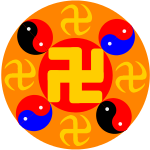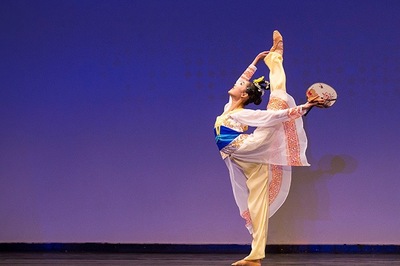The Shen Yun dance-music-electrovisual experience might make you want to dredge up what was going on in 1950s China. In '50s America, "Oklahoma!" became a film, "Them" warned us about insect invaders, and HUAC warned us about doctrinal invaders. Shen Yun wishes '50s America had happened all over the world. It professes to present 5,000 years of Chinese culture. But, obsessed with events in '50s China, it gives us Debbie Reynolds instead.
The 1950s was the first full decade of Mao Zedong's Communist rule. And Shen Yun, founded in New York in 2006, acts as an anti-Communist army in exile. When its colorful vignettes depict idealistic youths being imprisoned, blinded and killed, the black-clad attackers wear red hammer-and-sickle patches on their backs. Shen Yun's cartoon springs from a kernel of truth: The arts organization's parent Falun Gong spiritual practice is considered treasonous by the Chinese government.
Other than long silk sleeves, today's audience of Chinese Americans and random curiosity seekers doesn't know what to expect. The advertised Chinese culture is limited mostly to folk tales dressed up with synchronized choreography and tilted to make political points. Several nervous attempts at Catskills humor could have been omitted to great advantage. Then, though, we would not have been privileged to snigger when a pair of urban modern men, distracted by their cell phones, lose track of their girlfriends and end up holding each other's hand (God forbid). The two could have dodged the transgression if they had availed themselves of peaceful transcendence offered by nearby Falun Gong dancers, unfortunately garbed in polo shirts and pleated chinos reminiscent of Scientology or Hitler Youth.
Even more unfortunate: A 10-second Wikipedia search reveals that the Falun Gong emblem has a swastika in the middle. Of course, that symbol far predates fascism, and the kreuz is flipped, so let's say it could symbolize, y'know, the reverse of Nazi nastiness. Still, zeal to whack Commie tyranny can lead the righteous to dally with the unholy opposite.
Most unfortunate: The music feels less like Chinese traditional fare than like a Hollywood soundtracker's idea of same. The few Chinese instruments serve in Westernized roles, and the tidy, feeble arrangements executed by a 20-plus-member orchestra are almost untainted by ancient scales and harmonies.
Subtext aside, Shen Yun is a nice spectacle. One older Asian attendee, having been treated to Valhalla stage fog, miraculous resurrections, and savior angels leaping onto the stage from rear-screen palaces of the photonic ideal, said she felt as if she were in heaven. Hell dwellers can sympathize.


